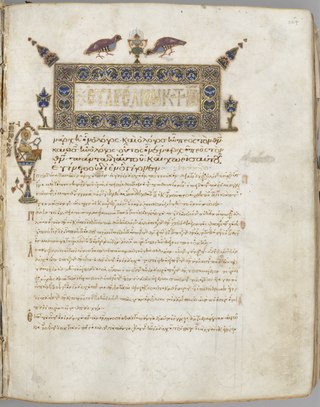
An illuminated manuscript is a formally prepared document where the text is often supplemented with flourishes such as borders and miniature illustrations. Often used in the Roman Catholic Church for prayers, liturgical services and psalms, the practice continued into secular texts from the 13th century onward and typically include proclamations, enrolled bills, laws, charters, inventories and deeds.
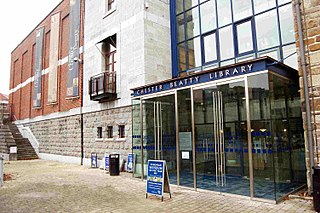
The Chester Beatty Library, now known as the Chester Beatty, is a museum and library in Dublin. It was established in Ireland in 1953, to house the collections of mining magnate, Sir Alfred Chester Beatty. The present museum, on the grounds of Dublin Castle, opened on 7 February 2000, the 125th anniversary of Beatty's birth and was named European Museum of the Year in 2002.

The Codex Argenteus is a 6th-century illuminated manuscript, originally containing part of the 4th-century translation of the Christian Bible into the Gothic language. Traditionally ascribed to the Arian bishop Wulfila, it is now established that the Gothic translation was performed by several scholars, possibly under Wulfila's supervision. Of the original 336 folios, 188—including the Speyer fragment discovered in 1970—have been preserved, containing the translation of the greater part of the four canonical gospels. A part of it is on permanent display at the Carolina Rediviva building in Uppsala, Sweden, under the name "Silverbibeln".

The book of hours is a Christian devotional book used to pray the canonical hours. The use of a book of hours was especially popular in the Middle Ages and as a result, they are the most common type of surviving medieval illuminated manuscript. Like every manuscript, each manuscript book of hours is unique in one way or another, but most contain a similar collection of texts, prayers and psalms, often with appropriate decorations, for Christian devotion. Illumination or decoration is minimal in many examples, often restricted to decorated capital letters at the start of psalms and other prayers, but books made for wealthy patrons may be extremely lavish, with full-page miniatures. These illustrations would combine picturesque scenes of country life with sacred images. Books of hours were usually written in Latin, although there are many entirely or partially written in vernacular European languages, especially Dutch. The closely related primer is occasionally considered synonymous with books of hours, but their contents and purposes could deviate significantly from the simple recitation of the canonical hours. Tens of thousands of books of hours have survived to the present day, in libraries and private collections throughout the world.
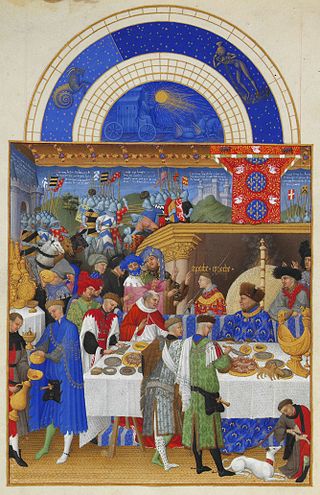
The Très Riches Heures du Duc de Berry or Très Riches Heures, is the most famous and possibly the best surviving example of manuscript illumination in the late phase of the International Gothic style. It is a book of hours: a collection of prayers to be said at the canonical hours. It was created between c. 1412 and 1416 for the extravagant royal bibliophile and patron John, Duke of Berry, by the Limbourg brothers. When the three painters and their sponsor died in 1416, possibly victims of plague, the manuscript was left unfinished. It was further embellished in the 1440s by an anonymous painter, who many art historians believe was Barthélemy d'Eyck. In 1485–1489, it was brought to its present state by the painter Jean Colombe on behalf of the Duke of Savoy. Acquired by the Duc d'Aumale in 1856, the book is now MS 65 in the Musée Condé, Chantilly, France.

The Froissart of Louis of Gruuthuse is a heavily illustrated deluxe illuminated manuscript in four volumes, containing a French text of Froissart's Chronicles, written and illuminated in the first half of the 1470s in Bruges, Flanders, in modern Belgium. The text of Froissart's Chronicles is preserved in more than 150 manuscript copies. This is one of the most lavishly illuminated examples, commissioned by Louis of Gruuthuse, a Flemish nobleman and bibliophile. Several leading Flemish illuminators worked on the miniatures.

A treasure binding or jewelled bookbinding is a luxurious book cover using metalwork in gold or silver, jewels, or ivory, perhaps in addition to more usual bookbinding material for book-covers such as leather, velvet, or other cloth. The actual bookbinding technique is the same as for other medieval books, with the folios, normally of vellum, stitched together and bound to wooden cover boards. The metal furnishings of the treasure binding are then fixed, normally by tacks, onto these boards. Treasure bindings appear to have existed from at least Late Antiquity, though there are no surviving examples from so early, and Early Medieval examples are very rare. They were less used by the end of the Middle Ages, but a few continued to be produced in the West even up to the present day, and many more in areas where Eastern Orthodoxy predominated. The bindings were mainly used on grand illuminated manuscripts, especially gospel books designed for the altar and use in church services, rather than study in the library.

The Paris Psalter is a Byzantine illuminated manuscript, 38 x 26.5 cm in size, containing 449 folios and 14 full-page miniatures. The Paris Psalter is considered a key monument of the so-called Macedonian Renaissance, a 10th-century renewal of interest in classical art closely identified with the emperor Constantine VII Porphyrogenitus (909-959) and his immediate successors.

The Hours of Jeanne d'Evreux is an illuminated book of hours in the Gothic style. According to the usual account, it was created between 1324 and 1328 by Jean Pucelle for Jeanne d'Evreux, the third wife of Charles IV of France. It was sold in 1954 to the Metropolitan Museum of Art in New York where it is now part of the collection held at The Cloisters, and usually on display.

The Hours of Catherine of Cleves is an ornately illuminated manuscript in the Gothic art style, produced in about 1440 by the anonymous Dutch artist known as the Master of Catherine of Cleves. It is one of the most lavishly illuminated manuscripts to survive from the 15th century and has been described as one of the masterpieces of Northern European illumination. This book of hours contains the usual offices, prayers and litanies in Latin, along with supplemental texts, decorated with 157 colorful and gilded illuminations. Today, both parts of the manuscript that forms this book are housed at the Morgan Library and Museum in New York City.
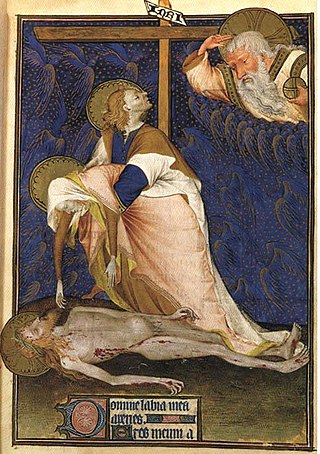
The Grandes Heures de Rohan is an illuminated manuscript book of hours, painted by the anonymous artist known as the Rohan Master, probably between 1418 and 1425, in the Gothic style. It contains the usual offices, prayers and litanies in Latin, along with supplemental texts, decorated with 11 full page, 54 half page, and 227 small miniatures, decorated with tempera paints and gold leaf. The book margins are decorated with Old Testament miniatures with captions in Old French, in the style of a Bible moralisée. The full page illuminations are renowned for the highly emotional and dramatic portrayal of the agonies of Christ and the grief of the Virgin. According to Millard Meiss, "The Rohan Master cared less about what people do than what they feel. Whereas his great predecessors excelled in the description of the novel aspects of the natural world, he explored the realm of human feeling." Meiss concludes that the Rohan Master was the "greatest expressionist in 15th century France." The manuscript is currently housed in the Bibliothèque Nationale, Paris, France.

The Ravenelle Painter, also known as the Master of the Book of Hours of Johannete Ravenelle, the Ravenelle Master or the First Master of the Bible Historiale of Jean de Berry, was a French manuscript illuminator active between 1390 and 1405. Little is known about him. In a 2002 dissertation, Eva Lindqvist Sandgren used stylistic comparison to identify this artist as the illuminator of a book of hours now in the Uppsala University Library, the Ravenelle Hours. This identification is now widely accepted. An earlier notname for the same artist derives from a manuscript of the Bible Historiale, now held by the Bibliothèque nationale de France in Paris, in which he painted several miniatures. The manuscript was once owned by John, Duke of Berry, and with most books containing other work ascribed to the artist seems to have been produced in Paris. This would indicate that the artist lived and worked there, producing large secular works as well as religious treatises written in vernacular French.
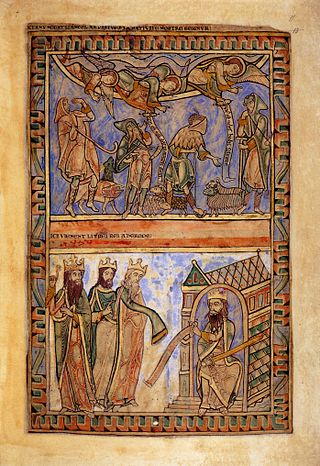
The Winchester Psalter is an English 12th-century illuminated manuscript psalter, also sometimes known as the Psalter of Henry of Blois, and formerly known as the St Swithun's Psalter. It was probably made for use in Winchester, most scholars agreeing that the most likely patron was the Henry of Blois, brother of Stephen, King of England, and Bishop of Winchester from 1129 until his death in 1171. Until recent decades it was "a little-studied masterpiece of English Romanesque painting", but it has been the subject of several recent studies.
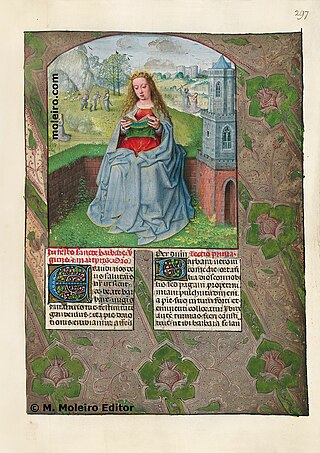
The Isabella Breviary is a late 15th-century illuminated manuscript housed in the British Library, London. Queen Isabella I of Castile was given the manuscript shortly before 1497 by her ambassador Francisco de Rojas to commemorate the double marriage of her children and the children of Emperor Maximilian of Austria and Duchess Mary of Burgundy.

The Black Hours, MS M.493 is an illuminated book of hours completed in Bruges between 1460 and 1475. It consists of 121 pages (leaves), with Latin text written in Gothic minuscule script. The words are arranged in rows of fourteen lines and follow the Roman version of the texts. The lettering is inscribed in silver and gold and placed within borders ornamented with flowers, foliage and grotesques, on pages dyed a deep blueish black. It contains fourteen full-page miniatures and opens with the months of the liturgical calendar, followed by the Hours of the Virgin, and ends with the Office of the Dead.

The Hours of Philip the Bold is a late 14th-century illuminated book of hours produced in Paris for Philip the Bold, Duke of Burgundy (1363-1404). It contains illustrated calendars, figured initials and 11 large miniatures with ivy borders, following the Paris liturgy. The manuscript has a devotional use. Philip reportedly recited his daily prayers from this manuscript. His hours, which contains almost 200 images, is one of the most worldly manuscripts to survive from the library of the Burgundian Dukes. It is now MS. 3-1954 in the Fitzwilliam Museum, Cambridge.

The Sforza Hours, is a richly illuminated book of hours initiated by Bona Sforza, widow of Galeazzo Sforza, Duke of Milan, around 1490, who commissioned the illuminator Giovanni Pietro Birago. The book remained in an unfinished state for 30 years until Margaret of Austria, Regent of the Netherlands, commissioned its completion in 1517–20 from the artist Gerard Horenbout. The book therefore contains decoration of the highest quality by two artists. It provides a unique example of an early sixteenth-century Northern Renaissance illuminator's response to Milanese art of the late Quattrocento. The history of the Sforza Hours also includes one of the earliest recorded examples of art theft.

The Emperor's Bible, also known as Codex Caesareus, Codex Caesareus Upsaliensis or the Goslar Gospels, is an 11th-century illuminated manuscript currently in Uppsala University Library, Sweden. Despite its name, it is not a Bible but a Gospel Book. The book was made in the scriptorium of Echternach Abbey, and is one of four preserved large Gospel Books made there during the 11th century. It was commissioned by Emperor Henry III and donated by him to Goslar Cathedral, where it remained until the Thirty Years' War. It was then lost for about 100 years. Its previous richly decorated cover was also lost at this time at the latest. The book later appeared again in the possession of Swedish diplomat and civil servant Gustaf Celsing the Elder. At the death of his son, it was acquired by Uppsala University.

The Book of hours of Frederick of Aragon or simply the Hours of Frederick of Aragon is a luxury book of hours, a private devotional book, made for Frederick of Aragon between 1501 and 1502. Described as a "particularly accomplished work of art", it is the result of cooperation between three different artists, Ioan Todeschino, Jean Bourdichon, and the Master of Claude de France. The 62 full-page miniatures were made by Bourdichon, and have been described as some of his best work, while the border decorations were made by Todeschino and the Master of Claude de France. Following the death of Frederick, the book probably eventually ended up in Spain, and eventually entered the library of Joseph Bonaparte. It was eventually lost by him and finally bought by the predecessor of today's Bibliothèque nationale de France, the French national library, in 1828. It is kept in the library collections in Paris and has been exhibited to the public on several occasions.

The Hours of Charles the Noble is a book of hours made in Paris in the early 15th century, and bought by Charles III of Navarre, called "the Noble", in 1404 or 1408. Since 1964 it has been in the collection of the Cleveland Museum of Art in Cleveland, Ohio, United States. It was decorated by an international team of illuminators and illustrators of at least six people, headed by the so-called Master of the Brussels Initials. It was probably bought ready-made by Charles, who later had his coat of arms added to it in several places.




















